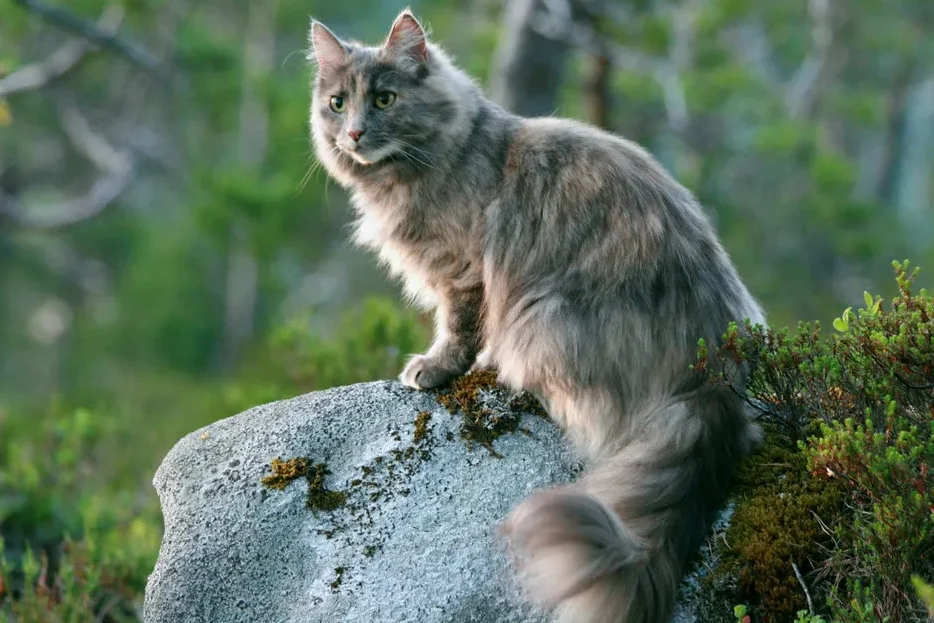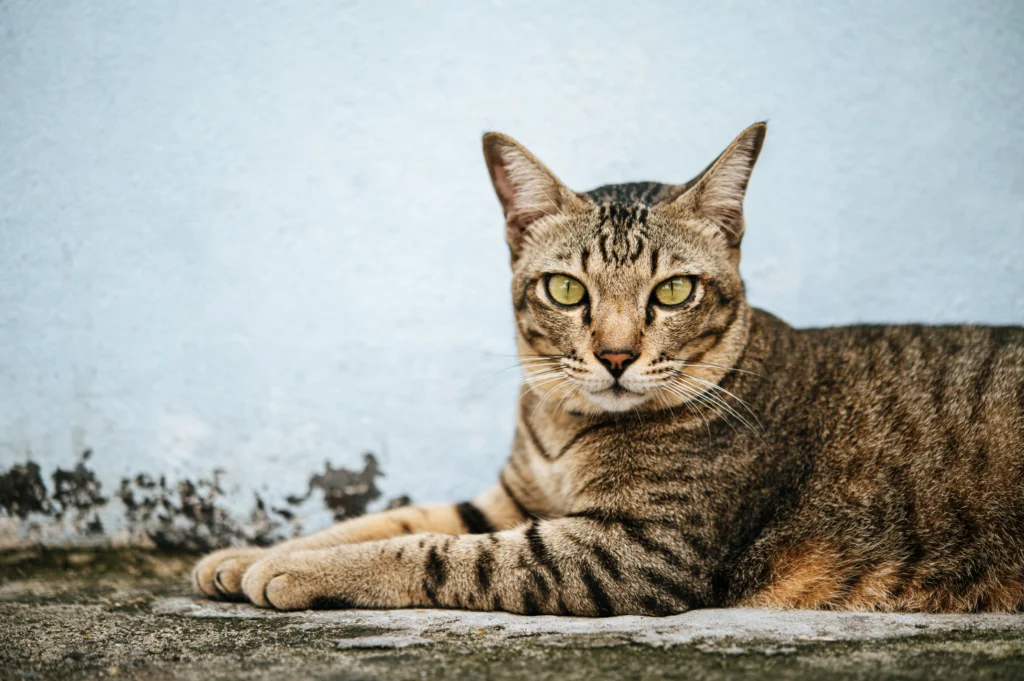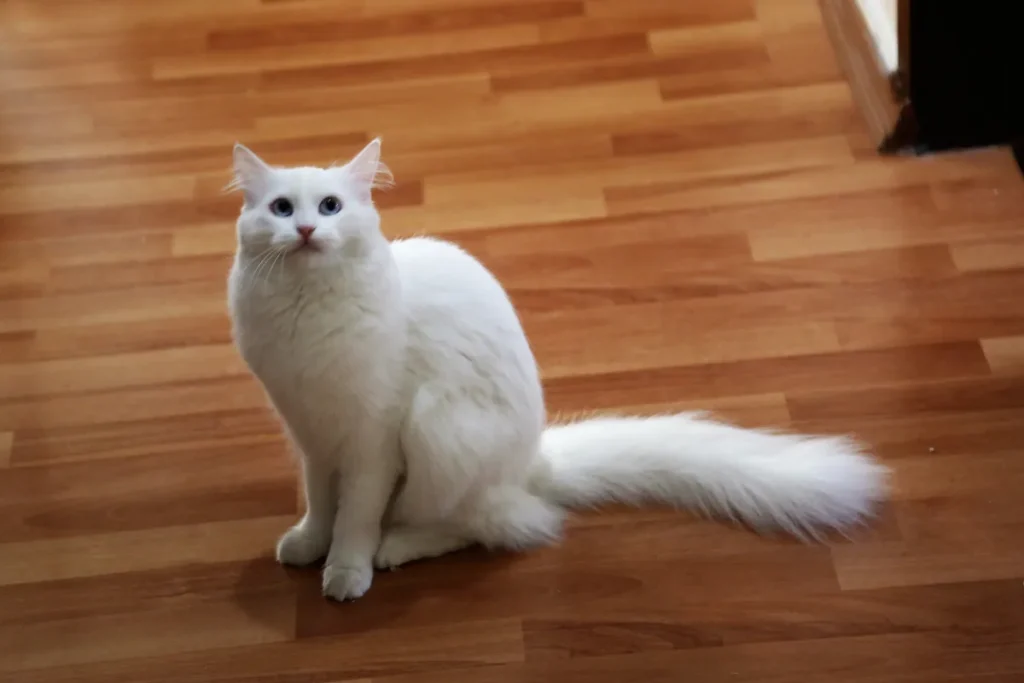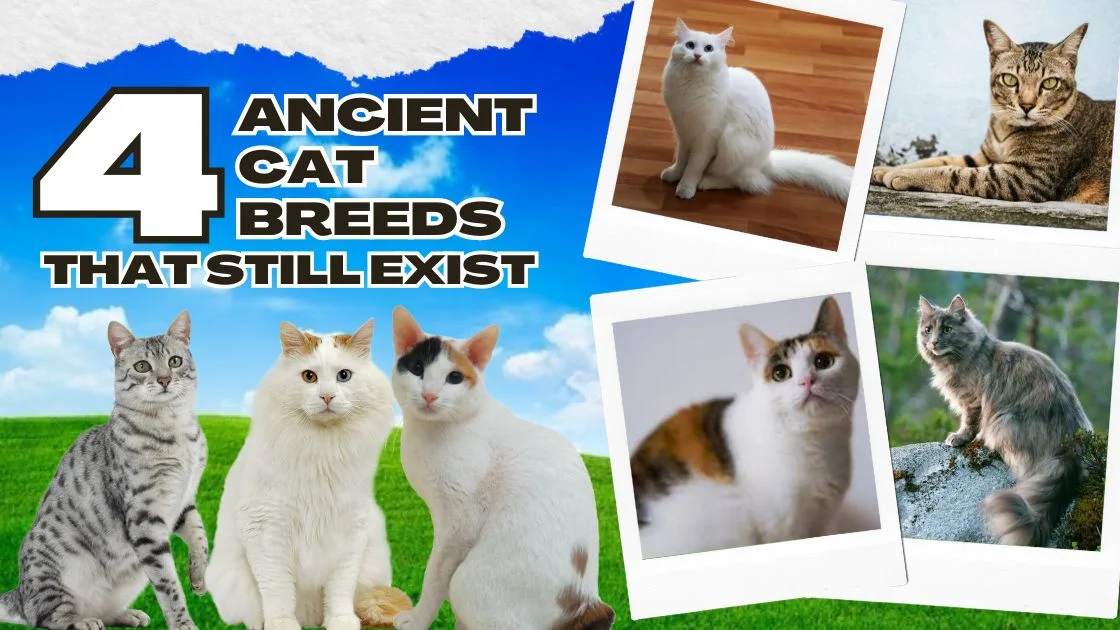Come into the exciting cat world of ancient cat breeds. Learn about their history, charm, and timeless elegance in this guide. We’ll explore 4 Ancient Cat Breeds That Still Exist. Discover what makes them unique, talk about things to think about if you want one, and see what they all have in common that makes people love them for a long time.
Exploring Oldest Cat Breeds in Existence Today
Take a trip with us to learn about ancient cat breeds. They have fascinating stories, from mysterious beginnings to unique traits. These cats create enchanting tales that all cat lovers around the world enjoy. The Norwegian Forest Cat, Egyptian Mau, Turkish Angora, and Japanese Bobtail have remained charming for many years. Their unique traits, full of history, keep capturing hearts. People all around the world love these ancient cat breeds forever.
4 Ancient Cat Breeds That Still Exist
Now, we will Explore 4 Ancient Cat Breeds That Still Exist Today;
1. Norwegian Forest Cat

Historical background and origins
The Norwegian Forest Cat is one of the oldest cat breeds and comes from Norse myths, showing strength. This particular cat was with goddess Freyja and guarded sacred forests. Sailors thought they brought luck on trips. They were crucial in Norse culture.
Physical Characteristics
The Norwegian Forest Cat is ready for the cold in Scandinavia. Its warm coat, tufted ears, muscular body, and big eyes show this. The coat and ears help in cold weather, and its rigid body is suitable for hunting.
Unique Traits and Behaviors
Norwegian Forest Cats are intelligent and love to play. They become friends with people and stay playful their whole lives. Playing with them is essential for their happiness and health. They are intelligent and gentle, making them great friends.
Popularity and Recognition
The Norwegian Forest Cat is famous worldwide. It does well in cat shows, making judges and fans happy. People love sharing its charm on social media. Owners talk excitedly about the love these cats bring, showing they are always popular.
2. Egyptian Mau

Ancient Egyptians connection
The ancient Egyptian Mau is the oldest domesticated cat breed with an incredible story from ancient Egypt. These particular cats were important and loved by Egyptians. They were like symbols of gods and goddesses. Learning about this history shows how significant Egyptian Maus were in ancient Egypt.
Spotted Coat and Distinctive Markings
The Egyptian Mau looks fantastic with its spotted coat. The spots are unique and remind us of the cat’s old family. Each place is like a symbol of the cat’s grace that Egyptians loved. Having this cat at home makes it look even more beautiful.
Personality and Temperament
Discovering the Egyptian Mau’s personality is like finding a fun story of playfulness and love. These cats are charming and love to be with people. They play a lot and become good friends with humans. Their playful actions and loving gestures create a special bond with people who understand cats well.
Modern-Day Appreciation
The Egyptian Mau has a long history, but today, people still love this domestic cat. Modern cat fans really like this particular cat. Lots of time passed, but people still love the Egyptian Mau. It’s a favorite and stays unique as a beloved cat friend. Ancient cat breeds, like in Egypt, are still loved today.
The Egyptian Mau stays popular because it has a unique mix of history and looks. People love having it as a cat friend because it’s graceful and playful.
3. Turkish Angora

Ancient Anatolian roots
The Turkish Angora comes from ancient times in Anatolia. People respected these elegant cats back then. With its ancient cultures, Anatolia is where the Turkish Angora first appeared. They became part of the rich history of this place. Looking into where they come from shows a connection for many years. The Turkish Angora is still here. It keeps alive the history of Anatolian civilizations and their cat friends.
Luxurious Coat and Colors
The Turkish Angora is famous for its beautiful long fur that feels silky and looks luxurious. Their fancy fur and many colors make them like living art. Whether they’re pure white or have other pretty colors, Turkish Angora fur makes any home look royal and more beautiful.
Intelligence and Playfulness
The Turkish Angora is charming because it’s both intelligent and playful. These cats are famous for being clever and learning fast. They love to play a lot. Their brilliant minds help them fit into different places easily. Their playful actions make things fun all the time. If you want a lively and intelligent cat friend, the Turkish Angora is an excellent choice.
Cultural Significance
Looking into Turkish stories shows how special the Turkish Angora is. In Turkish traditions, these cats are not just pets; they bring good luck. People in the region of Turkey loved them because they thought they were symbols of fortune. Learn about these elegant cats. They affected a whole nation’s thoughts. They’re not regular pets but important symbols in Turkish stories and traditions.
The Turkish Angora has been elegant and essential from ancient Anatolia to now. They keep being charming and unique. These fancy cats make homes better with their royal presence. They bring a rich history and will be loved for a long time, showing they are essential friends with a great past and a bright future.
4. Japanese Bobtail

Cultural importance in Japan
The Japanese Bobtail is very special in Japan. It’s not just a cat; it means a lot more. People in Japan have respected and loved the Japanese Bobtail for a very long time. They are part of Japanese stories and represent good luck and happiness. In Japan, these cats are not just pets; they are connected to old traditions and beliefs that are still important today. This makes them more meaningful than just being cute and different-looking.
Distinctive Bobbed Tail
The Japanese Bobtail is charming because of its unique tail. It’s short and sometimes has a kink, making it different from other cats. This distinctive tail adds a fun touch to the cat’s look, making it cute and easy to remember. The tail makes the cat look nice. It tells us the Japanese Bobtail is unique and one-of-a-kind among cat friends.
Personality Traits
Looking at the Japanese Bobtail’s personality, we see they are friendly and nice. They are more than just pets; they enthusiastically participate in their human friends’ daily lives. Being social helps them make solid bonds and feel like friends, not just pets. Japanese Bobtails talk with meows and body language. They make interactions with people memorable and meaningful.
Rising Popularity Worldwide
More and more people like the Japanese Bobtail cat. It’s becoming popular beyond Japan. What was once a well-kept secret in its country of origin has now become a global phenomenon. Cat lovers everywhere really like the Japanese Bobtail. It’s special because of its cultural importance, unique looks, and friendly personality. People worldwide love this cat breed, showing that particular cats can be loved by everyone and bring different cultures together. The Japanese Bobtail is a fantastic cat that people everywhere appreciate.
The Japanese Bobtail is not just a cat; it’s a unique symbol of luck, happiness, and friendship. Its unique look and friendly nature are loved by people worldwide. This ensures that the Japanese Bobtail cat breed still popular and loved for a long time.
Comparisons and Contrasts
Comparing old cat breeds helps us learn a lot. Each breed has unique features that help us choose the right cat for a good friendship.
Unique Features of Each Breed: Navigating Distinct Characteristics
Learning about each old cat breed is like going on a fun discovery trip. The Norwegian Forest Cat is fluffy and robust. The Egyptian Mau looks royal with spots. Turkish Angoras are elegant with silky fur. Japanese Bobtails are charming with short tails. Knowing these unique features is essential for people thinking about getting a cat. It helps them understand how each cat looks, feels, and acts, making it easier to choose the perfect one.
Consideration for Prospective Cat Owners: Tailoring to Unique Needs
People who want a cat should think carefully about the ancient breeds. The Norwegian Forest Cat likes to climb and play, while the Egyptian Mau is more independent. Brush Turkish Angoras a lot for their fancy fur. Japanese Bobtails are friendly and love people. New owners, think about these things for a happy home with your special cat friends.
Commonalities Among Ancient Cat Breeds: Unifying Traits of Enduring Appeal
Ancient cat breeds are different, but they also have things in common. Many share things like being smart, adapting well, and affectionate. These common traits make them charming and suitable as pets in different homes. Knowing these shared qualities helps us love and bond with these timeless cats.
Look at different ancient cat breeds to choose a pet. Learn what makes each cat unique. Know how to take care of them. Find out what traits they share to be great friends.
Nurturing Ancient Cat Breeds: A Holistic Approach to Well-being
To care for ancient cat breeds, we must consider what they eat, get them good vet care, make their homes enjoyable, and choose good sources.
Dietary Considerations: Tailoring Nutrition for Health and Vitality
Feed ancient cats the right food for their health. Know what each cat needs to eat. Some cats need hearty food, like the Norwegian Forest Cat. Others need a balanced diet, like the Turkish Angora. Feed them right for a solid and long life.
Veterinary Care for Specific Needs: Ensuring Optimal Health through Regular Check-ups
Take your cat to the vet regularly. Vets know what each cat needs. They give shots and check for problems. Going to the vet helps keep your cat healthy and happy for a long time.
Creating a Stimulating Environment: Nurturing the Intellect of Intelligent Breeds
Make homes fun for intelligent cats. Give them toys and things to climb. Make them think and play. This keeps smart cats happy and healthy. They stay active and enjoy life.
Adopting from Reputable Sources: Ethical Choices for Well-being
Taking care of ancient cat breeds starts with making good choices when getting them. Picking good breeders or adopting from rescue groups ensures cats are treated well. This careful choice stops supporting bad breeding and protects cats, respecting their breeds.
Taking care of ancient cat breeds means being careful with what they eat, going to the vet, making their homes attractive, and getting them in a good way. This cautious way shows how committed we are to keeping these special cats healthy and happy for a long time. It’s important to create homes that focus on their needs and well-being.
The Future of Ancient Cat Breeds: Sustaining Legacy and Heritage
Thinking about what will happen to ancient cat breeds involves looking at how we keep them safe, breed them carefully, and get people interested worldwide. These are important to ensure these special cats stay around long.
A. Preservation Efforts and Breeding Programs: Safeguarding Genetic Diversity
Looking into keeping ancient cat breeds involves checking how we keep them safe and breed them. It’s essential to work on saving their unique genes and history. Knowing what makes each breed special helps create careful breeding programs. These programs protect their unique qualities, keeping their legacy safe for the future.
B. Ensuring the Longevity of These Breeds: A Commitment to Responsible Practices
Ensuring ancient cat breeds stay healthy and happy depends on good breeders and careful owners. Breeders must focus on the cat’s health and temperament and keep their unique traits. Owners play a big part, too, by giving good care, suitable homes, and treating them well. Everyone’s job is essential to keep these special cats around today.
C. Global Interest and Participation: A Driving Force for Preservation
Watching more people worldwide get interested in ancient cat breeds is essential to what will happen next. The more people like these breeds everywhere, the more they stay popular and are kept safe. People from all over working together make a community that cares about these cats, no matter where they are. Everyone is committed to keeping them safe and ensuring they remain around.
To keep ancient cat breeds, we must save them, breed them carefully, and have people worldwide help. Everyone must ensure these special cats continue so the next generations can love their beauty, charm, and history.
Conclusion
In conclusion, ancient cat breeds are unique and loved. Cat fans adore them for their histories and individual traits. Taking good care of these cats is essential for their well-being and happiness. Owners and their special cats promise to improve each other’s lives. Everyone should know the history and importance of ancient feline breeds. Understanding the stories and symbols keeps these cats safe for the future. Having ancient cat breeds at home makes it regal and continues stories from long ago. In the future, our promise to care for them and love their history ensures these cats will always be unique, valued, and lasting.
FAQs
A. How can I adopt an ancient cat breed?
If you want an ancient cat breed, look for good breeders or think about adopting from rescue groups that focus on these breeds.
B. Are these breeds suitable for families with children?
Many ancient cat breeds, like the ones we discussed, can be excellent for families with children if they get the proper care and attention.
C. What health considerations should I be aware of?
Each ancient cat breed may have specific health considerations. Regular veterinary check-ups and a proper diet tailored to their needs are essential for their well-being.
D. How can I connect with other ancient cat breed enthusiasts?
Go online, join forums or social groups, and attend cat shows to meet people who like ancient cat breeds.
E. Are these breeds hypoallergenic?
No cat is entirely hypoallergenic, but some people with allergies might find certain ancient breeds easier because they shed less hair and produce less dander.



Your blog is a gratitude sanctuary, offering solace and comfort in the embrace of thankfulness. Thank you for the refuge!